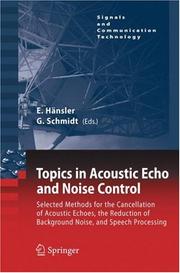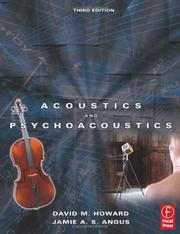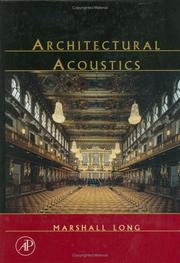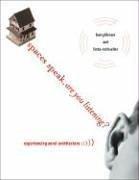| Listing 1 - 10 of 13 | << page >> |
Sort by
|

ISBN: 0415386802 0415386799 Year: 2006 Publisher: London ; New York : Taylor & Francis,
Abstract | Keywords | Export | Availability | Bookmark
 Loading...
Loading...Choose an application
- Reference Manager
- EndNote
- RefWorks (Direct export to RefWorks)
Sound. --- Acoustical engineering. --- Son --- Acoustique appliquée

ISBN: 354033212X 9786610615360 1280615362 3540332138 Year: 2006 Publisher: Hoboken, N.J. : Wiley-Interscience,
Abstract | Keywords | Export | Availability | Bookmark
 Loading...
Loading...Choose an application
- Reference Manager
- EndNote
- RefWorks (Direct export to RefWorks)
In this book, an international team of highly qualified experts treats important topics in acoustic echo and noise control and reports the latest developments. Methods for enhancing the quality of speech signals are gaining growing attention in universities and in industrial development laboratories. This book is organized in five parts: Part I gives a short introduction to acoustic echo and noise control. Part II deals with multi-microphone processing. In Part III, advanced methods for both linear and nonlinear echo cancellation are presented, and techniques for intelligent control of hands-free telephones are introduced. Part IV is devoted to noise reduction procedures. An in-depth treatment of conventional and of advanced methods is given, followed by a model based approach using Kalman filters. Finally, in Part V, selected applications of acoustic echo and noise control as well as speech and audio processing in general are outlined. Topics such as auditory scene analysis, wave field synthesis for spatial sound reproduction, in-car communication systems, and hearing aids are treated.
Engineering. --- Acoustics. --- Signal, Image and Speech Processing. --- Construction --- Industrial arts --- Technology --- Echo suppression (Telecommunication) --- Acoustical engineering.

ISBN: 9780240519951 0240519957 Year: 2006 Publisher: Amsterdam ; Boston ; London : Focal Press,
Abstract | Keywords | Export | Availability | Bookmark
 Loading...
Loading...Choose an application
- Reference Manager
- EndNote
- RefWorks (Direct export to RefWorks)
Acoustical engineering --- Psychoacoustics --- Music --- Acoustique appliquée --- Psychoacoustique --- Musique --- Acoustics and physics --- Acoustique et physique
Book
ISBN: 9780966516210 Year: 2006 Publisher: Pasadena, CA : Audio Engineering Associates,
Abstract | Keywords | Export | Availability | Bookmark
 Loading...
Loading...Choose an application
- Reference Manager
- EndNote
- RefWorks (Direct export to RefWorks)
Acoustical engineering --- Génie acoustique. --- Sound-waves --- Ondes sonores. --- Electro-acoustics --- Électroacoustique. --- Génie acoustique. --- Électroacoustique.
Book
ISBN: 142440469X 1509091653 Year: 2006 Publisher: New York : IEEE,
Abstract | Keywords | Export | Availability | Bookmark
 Loading...
Loading...Choose an application
- Reference Manager
- EndNote
- RefWorks (Direct export to RefWorks)
Speech processing systems --- Electro-acoustics --- Signal processing --- Electroacoustics --- Acoustical engineering --- Electrical engineering --- Music --- Sound --- Acoustics and physics
Book
ISBN: 3031025555 Year: 2006 Publisher: Cham : Springer International Publishing : Imprint: Springer,
Abstract | Keywords | Export | Availability | Bookmark
 Loading...
Loading...Choose an application
- Reference Manager
- EndNote
- RefWorks (Direct export to RefWorks)
Speech dynamics refer to the temporal characteristics in all stages of the human speech communication process. This speech “chain” starts with the formation of a linguistic message in a speaker's brain and ends with the arrival of the message in a listener's brain. Given the intricacy of the dynamic speech process and its fundamental importance in human communication, this monograph is intended to provide a comprehensive material on mathematical models of speech dynamics and to address the following issues: How do we make sense of the complex speech process in terms of its functional role of speech communication? How do we quantify the special role of speech timing? How do the dynamics relate to the variability of speech that has often been said to seriously hamper automatic speech recognition? How do we put the dynamic process of speech into a quantitative form to enable detailed analyses? And finally, how can we incorporate the knowledge of speech dynamics into computerized speech analysis and recognition algorithms? The answers to all these questions require building and applying computational models for the dynamic speech process. What are the compelling reasons for carrying out dynamic speech modeling? We provide the answer in two related aspects. First, scientific inquiry into the human speech code has been relentlessly pursued for several decades. As an essential carrier of human intelligence and knowledge, speech is the most natural form of human communication. Embedded in the speech code are linguistic (as well as para-linguistic) messages, which are conveyed through four levels of the speech chain. Underlying the robust encoding and transmission of the linguistic messages are the speech dynamics at all the four levels. Mathematical modeling of speech dynamics provides an effective tool in the scientific methods of studying the speech chain. Such scientific studies help understand why humans speak as they do and how humans exploit redundancy and variability by way of multitiered dynamic processes to enhance the efficiency and effectiveness of human speech communication. Second, advancement of human language technology, especially that in automatic recognition of natural-style human speech is also expected to benefit from comprehensive computational modeling of speech dynamics. The limitations of current speech recognition technology are serious and are well known. A commonly acknowledged and frequently discussed weakness of the statistical model underlying current speech recognition technology is the lack of adequate dynamic modeling schemes to provide correlation structure across the temporal speech observation sequence. Unfortunately, due to a variety of reasons, the majority of current research activities in this area favor only incremental modifications and improvements to the existing HMM-based state-of-the-art. For example, while the dynamic and correlation modeling is known to be an important topic, most of the systems nevertheless employ only an ultra-weak form of speech dynamics; e.g., differential or delta parameters. Strong-form dynamic speech modeling, which is the focus of this monograph, may serve as an ultimate solution to this problem. After the introduction chapter, the main body of this monograph consists of four chapters. They cover various aspects of theory, algorithms, and applications of dynamic speech models, and provide a comprehensive survey of the research work in this area spanning over past 20~years. This monograph is intended as advanced materials of speech and signal processing for graduate-level teaching, for professionals and engineering practitioners, as well as for seasoned researchers and engineers specialized in speech processing.

ISBN: 9780124555518 0124555519 Year: 2006 Publisher: Amsterdam Elsevier Academic Press
Abstract | Keywords | Export | Availability | Bookmark
 Loading...
Loading...Choose an application
- Reference Manager
- EndNote
- RefWorks (Direct export to RefWorks)
Architectural acoustics --- Acoustique architecturale --- Architectural acoustics. --- 699.84 --- 534 --- Acoustics, Architectural --- Buildings --- Absorption of sound --- Acoustical engineering --- Sound --- Akoestiek (architectuur) --- Akoestiek (bouw) --- Bouwakoestiek --- Akoestiek --- Acoustics --- Environmental engineering

ISBN: 1281038415 9786611038410 0080527558 9780080527550 0124555519 9780124555518 Year: 2006 Publisher: Amsterdam Boston Elsevier/Academic Press
Abstract | Keywords | Export | Availability | Bookmark
 Loading...
Loading...Choose an application
- Reference Manager
- EndNote
- RefWorks (Direct export to RefWorks)
Architectural Acoustics offers a comprehensive overview of acoustical science at a level suitable for either advanced undergraduate or introductory graduate courses in architectural design and architectural engineering. The text is organized according to how sound interacts with built structures, going from simple geometries through complex building structures. The book begins with a brief but useful history of architecture and the role of acoustics, as well as overview of human perception of, sound, and then progresses through topics ranging from acoustic measurement, noise metrics and envi
Architectural acoustics. --- Sound. --- Acoustics --- Continuum mechanics --- Mathematical physics --- Physics --- Pneumatics --- Radiation --- Wave-motion, Theory of --- Acoustics, Architectural --- Buildings --- Absorption of sound --- Acoustical engineering --- Sound --- Environmental engineering
Book
ISBN: 1280626739 9786610626731 3540330178 Year: 2006 Publisher: Berlin : Springer,
Abstract | Keywords | Export | Availability | Bookmark
 Loading...
Loading...Choose an application
- Reference Manager
- EndNote
- RefWorks (Direct export to RefWorks)
Die behandelten Themen des technischen Lärmschutzes und des eng mit ihm verbundenen Schwingungsschutzes machen das Buch für Ingenieure vieler Branchen vom Maschinenbau bis zum Bauwesen einschließlich der Gebiete Arbeitssicherheit und Umweltschutz zu einer durch fünf Vorauflagen schon bewährten Wissensquelle. Das gilt sowohl für die tägliche Arbeit als auch für das Studium oder die individuelle Wissenserweiterung. Das Werk enthält physikalische Erläuterungen, Bemessungs-, Mess- und Bewertungsmethoden, mit umfangreichen Literatur- und Normenzitaten und ist mit vielen Bildern und Tabellen ausgestattet. Die Darstellungsweise orientiert sich an kompakten Fortbildungsveranstaltungen für Ingenieure. Das vorliegende Werk stellt eine intensive Überarbeitung und Aktualisierung (insbesondere im Bereich der Messtechnik), Erweiterung auf aktuelle Tendenzen (z. B. Adaptronik), aber konzeptionelle Fortsetzung des zuletzt 1996 im VDI-Verlag erschienenen Buches dar. Unter dem 1971 bis 1979 geführten Titel "Lärmbekämpfung" ist es in ganz Deutschland seit langem bekannt.
Acoustical engineering. --- Electronics. --- Microelectronics. --- Civil engineering. --- Engineering. --- Noise control. --- Machinery. --- Engineering Acoustics. --- Electronics and Microelectronics, Instrumentation. --- Civil Engineering. --- Engineering, general. --- Noise Control. --- Machinery and Machine Elements. --- Environmental engineering.

ISBN: 1282097016 9786612097010 026226871X 1429455314 9780262268714 9780262026055 0262026058 9781282097018 9780262250702 0262250705 9781429455312 026251317X 9780262513173 Year: 2006 Publisher: Cambridge, Mass. MIT Press
Abstract | Keywords | Export | Availability | Bookmark
 Loading...
Loading...Choose an application
- Reference Manager
- EndNote
- RefWorks (Direct export to RefWorks)
How we experience space by listening: the concepts of aural architecture, with examples ranging from Gothic cathedrals to surround sound home theater.
Space perception. --- Auditory perception. --- Architectural acoustics. --- Psychoacoustics. --- Sound --- Recording and reproducing --- Digital techniques. --- Acoustics, Architectural --- Buildings --- Sound perception --- Spatial perception --- Digital audio --- Digital sound recording --- Acoustics --- Absorption of sound --- Acoustical engineering --- Hearing --- Perception --- Word deafness --- Spatial behavior --- Figure-ground perception --- Geographical perception --- Psychophysics --- Digital electronics --- Environmental engineering --- Electronic books. --- ARTS/Music & Sound Studies --- ARCHITECTURE/General --- Architectural acoustics --- Auditory perception --- Psychoacoustics --- Space perception --- 699.84 --- 781.1 --- 699.844 --- 72.01 --- Akoestiek --- Architectuurtheorie ; over ruimte en geluid --- Continuum mechanics --- Mathematical physics --- Physics --- Pneumatics --- Radiation --- Wave-motion, Theory of --- Recording and reproducing&delete& --- Digital techniques --- Akoestiek (architectuur) --- Geluidskunst --- Geluidsisolatie. Lawaaibestrijding --- Architectuur ; theorie, filosofie, esthetica
| Listing 1 - 10 of 13 | << page >> |
Sort by
|

 Search
Search Feedback
Feedback About UniCat
About UniCat  Help
Help News
News